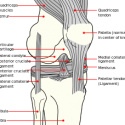01 Apr Osteoarthritis May Develop Early After ACL Rupture
 MedicalResearch.com Interview with:
MedicalResearch.com Interview with:
Adam Culvenor Ι B.Physio(Hons), PhD
Division of Physiotherapy
School of Health & Rehabilitation Sciences
The University of Queensland
Medical Research: What is the background for this study?
Dr. Culvenor: Knee injury, such as anterior cruciate ligament (ACL) rupture, is a well-recognised risk factor for the accelerated development of knee osteoarthritis (OA). Previous studies report high rates of knee osteoarthritis with radiographs (x-rays) more than 5-10 years following ACL injury and reconstruction (ACLR). However, once OA becomes well-established and visible on radiographs, management options are limited. Potential therapies may be better placed to target the early stages of disease when management strategies, such as optimising knee load, may be more efficacious. Magnetic resonance imaging (MRI) enables the assessment of early osteoarthritis features affecting any joint tissue. Yet, MRI has not previously been used to assess early knee OA within the first year following ACLR.
Medical Research: What are the main findings?
Dr. Culvenor: Of the 111 patients who were one year following an anterior cruciate ligament rupture, the prevalence of early knee OA assessed with MRI was much higher than previously recognised. Medial and lateral tibiofemoral osteoarthritis was observed in 6% and 11%, respectively, while 17% had patellofemoral OA. These patterns of early OA are similar to previous radiographic findings; the patellofemoral joint is at particular risk of OA. Specifically, the femoral trochlea was the region most affected by bone marrow lesions, cartilage lesions and osteophytes. The prevalence of structural pathology was much higher than the uninjured control group of similar age and activity level, highlighting the impact of knee trauma (injury and/or surgery).
Medical Research: What should clinicians and patients take away from your report?
Dr. Culvenor: Following anterior cruciate ligament (ACL) rupture, individuals demonstrating features of early OA should be encouraged to address modifiable factors that increase the risk of OA progression, such as elevated BMI, quadriceps weakness, and abnormal knee alignment. The high rate of early OA features we observed may indicate that post-operative rehabilitation programs need to shift away from their primary emphasis of an early return to sport, to include more specific elements of maintain long-term joint health. Clinicians should be alert to patellofemoral dysfunction following ACLR, as this compartment is at particular risk of early degenerative disease.
Medical Research: What recommendations do you have for future research as a result of this study?
Dr. Culvenor: This cohort of individuals, and others following ACL injury, need to be prospectively followed to identify the natural history of the osteoarthritis features observed, and to identify clinical and imaging risk factors for the accelerated progression of OA. The ultimate goal is developing efficacious interventions that modify post-traumatic disease progression. The identification of early OA following ACLR provides a good platform for this to be pursued.
Citation:
Early Knee Osteoarthritis Is Evident One Year Following Anterior Cruciate Ligament Reconstruction: A Magnetic Resonance Imaging Evaluation
Culvenor AG1, Collins NJ, Guermazi A, Cook JL, Vicenzino B, Khan KM, Beck N, van Leeuwen J, Crossley KM.
Arthritis Rheumatol. 2015 Apr;67(4):946-55. doi: 10.1002/art.39005.
MedicalResearch.com Interview with: Adam Culvenor Ι B.Physio(Hons), PhD (2015). Osteoarthritis May Develop Early After ACL Rupture
Last Updated on April 1, 2015 by Marie Benz MD FAAD
